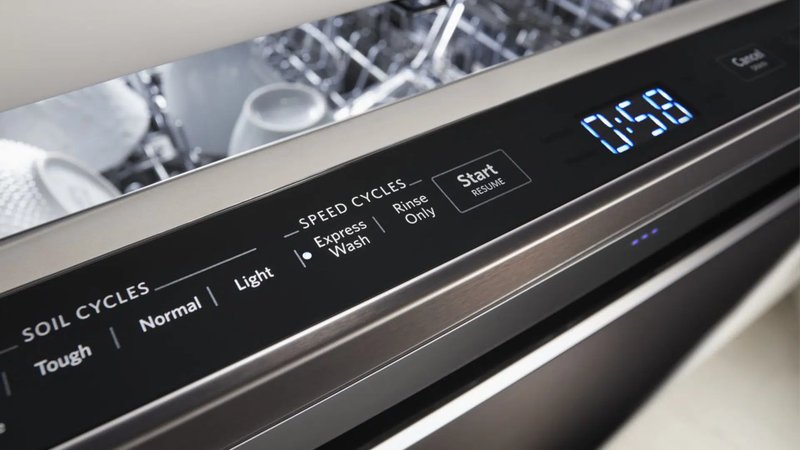
You might be wondering why your KitchenAid dishwasher is sending out these cryptic messages in the first place. The E3 code generally indicates an issue with heating—more specifically, the water isn’t reaching the correct temperature during the wash cycle. Just like your favorite cup of coffee needs to be the right temperature to be truly enjoyable, your dishwasher relies on hot water to clean effectively. Without this crucial element, your dishes might come out less than spotless. But fear not, understanding and resolving this issue is simpler than you might think!
Understanding the KitchenAid E3 Error Code
Here’s the deal: when your dishwasher displays the E3 error code, it’s likely pointing to a problem with the heating element or the thermostat. Imagine the heating element as the dishwasher’s internal radiator, warming up the water to a suitable temperature for dislodging stubborn food particles. If it’s not doing its job, the machine waves the E3 flag to catch your attention.
The heating element’s job is critical for ensuring your dishes come out clean and sanitized. Think of it like trying to wash a greasy saucepan in cold water—just not effective, right? The dishwasher needs to reach a specific temperature to clean and sanitize your dishes thoroughly. If you’re frequently seeing the E3 code, it might suggest the water isn’t heating as it should.
But before you jump into action mode, consider this: a faulty thermostat could also trigger the E3 code. The thermostat is akin to a kitchen timer; it ensures that the water in the dishwasher heats to the correct temperature before the wash cycle begins. If it’s misreading the temperature, the dishwasher might mistakenly think there’s an issue, hence the error code.
Common Causes of the E3 Code
So, why might your dishwasher be crying out with this error? One possible culprit is a malfunctioning heating element. Over time, like any hardworking appliance, parts can wear down and may no longer function as they should. If the heating element burns out, it simply can’t heat the water, and the E3 code will be your first clue that something’s off.
Another potential issue could be with the thermostat or temperature sensor, which sometimes gets dirty or misaligned. Think about trying to measure the room temperature with a thermometer that’s been left out in the sun—it’s likely not going to give an accurate reading. Similarly, if the thermostat is compromised, it might send false signals to the machine about the water temperature.
Lastly, your dishwasher’s wiring might also be at fault. If there’s any disconnection or a loose wire somewhere along the circuit, the error code could light up like a Christmas tree. It’s akin to having a faulty wire in your Christmas lights—one faulty wire can cut off power to the whole set, causing darkness when you least expect it.
Steps to Resolve the E3 Error
First things first: ensure your dishwasher is turned off and unplugged before attempting any fixes. Safety is key! Now, suppose the issue lies with the heating element. You might need to replace it. This could involve removing the bottom panel of the dishwasher to access the element. If you’re handy with tools, this can be a straightforward DIY. Just ensure you have the correct replacement part ready.
If the problem seems to be with the thermostat, a gentle cleaning might do the trick. Check that it’s secure and free of debris. Sometimes, a simple realignment and cleaning can resolve inaccuracies in temperature readings, much like cleaning your reading glasses.
For wiring issues, however, it might be best to call in a professional unless you’re confident in assessing and repairing electrical components. A pro can ensure all connections are secure and functioning—think of them like a detective solving the mystery of the error code for you.
Preventative Measures and Final Thoughts
Preventing the E3 error from reoccurring can save you from a lot of hassle down the line. Regular maintenance is your friend here. Make it a habit to run a periodic check on your dishwasher’s internal components, much like you would a routine car maintenance. This can help detect potential issues before they snowball into full-blown problems.
Another useful tip is to ensure that the dishwasher has optimal water pressure and the inlet valve is functioning correctly. Imagine trying to fill a bucket with a trickling tap—it’s going to take forever! Proper water flow and pressure not only help the heating element work efficiently but also ensure the whole cycle runs smoothly.
So there you have it! The E3 error code doesn’t have to be a source of frustration. With a little bit of attention and care, you can help your KitchenAid dishwasher continue to be the reliable kitchen companion it’s meant to be. If troubleshooting doesn’t resolve the issue, don’t hesitate to reach out for professional help. Sometimes, an expert touch is all that’s needed to keep things running smoothly.